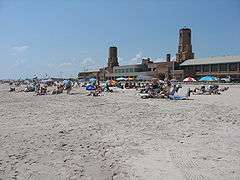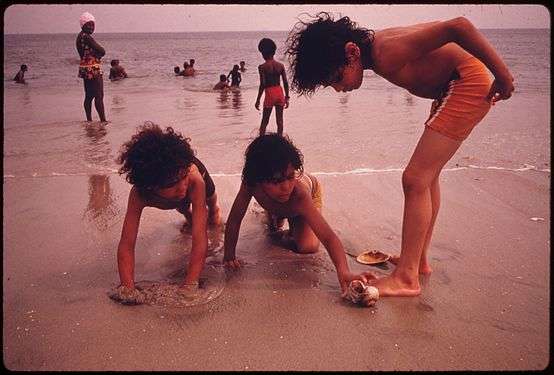Jacob Riis Park
|
Jacob Riis Park Historic District | |
 | |
   | |
| Nearest city | New York, New York |
|---|---|
| Coordinates | 40°34′3″N 73°52′24″W / 40.56750°N 73.87333°WCoordinates: 40°34′3″N 73°52′24″W / 40.56750°N 73.87333°W |
| Built | 1932 |
| Architect | Julius Burgevin; Multiple |
| Architectural style | Art Deco |
| NRHP Reference # | 81000081 |
| Added to NRHP | June 17, 1981[1] |
Jacob Riis Park in the New York City borough of Queens, is part of the Jamaica Bay Unit of the Gateway National Recreation Area, and is managed by the National Park Service (NPS). It lies at the foot of the Marine Parkway–Gil Hodges Memorial Bridge, toward the southwestern end the Rockaway Peninsula, just east of Fort Tilden and west of Rockaway Beach. The Jacob Riis Park Historic District features an extensive sand beach and an art deco bath house built in 1932, and is listed on the National Register of Historic Places. The bathhouse provides a place to get out of the sun and learn about the park's history. The park is named for Jacob Riis, a famous New York City muckraker journalist and photographer who documented the plight of the poor and working class.[2] It is associated with the Jacob Riis Park Historic District, which it is in.
History
The park was largely built on the site of the former Rockaway Naval Air Station, one of the first US naval air stations. Riis Park was designed by the politically powerful NYC Parks Commissioner Robert Moses, who had also created Jones Beach as a state park further east on Long Island in 1929.[2] Moses saw Riis Park as a Jones Beach for poor immigrants. The Atlantic Ocean beach, boardwalks, courtyards, and walkways gave the city's poor a respite from cramped tenements and crowded city streets.
Moses also wanted to bring public transportation closer to the park, so that it would be closer for poor immigrant citizens to travel to.[2] In addition to easy access via what are now MTA Bus Company routes Q22, Q35, a huge parking lot with over 5,000 parking spaces, the largest in the world at the time it was built, provides ample space for those who preferred to drive, though a fee is charged to park in the lot.[3] Also, the New York Water Taxi offered Rockaway ferry service starting in May 2008, though not at the time that Moses was Parks commissioner.[4] However, the nearest New York City Subway station is Rockaway Park – Beach 116th Street, over 1 mile (1.6 km) away on the A S trains, though a proposed expansion of the New York City Subway in 1929—around the same time that Moses was in office—had plans for such a subway extension to the park.
In 1972, Jacob Riis Park was transferred to the control of the National Park Service.[2] Today, its sand, surf, seaside recreation areas and famous Art Deco bathhouse are a popular summer destination. Facilities available in season include a pitch and putt golf course and food concessions.[2][5]
The historic district was listed on the National Register of Historic Places in 1981.[1]
 Children at the beach in 1974 in a photo taken by Danny Lyon
Children at the beach in 1974 in a photo taken by Danny Lyon- People enjoying the beach over Labor Day weekend in August 2013
 Riis parking lot served as a temporary dump for Hurricane Sandy debris
Riis parking lot served as a temporary dump for Hurricane Sandy debris
References
- 1 2 National Park Service (2008-04-15). "National Register Information System". National Register of Historic Places. National Park Service.
- 1 2 3 4 5 "Jacob Riis Park". Nyharborparks.org. Retrieved 2016-07-28.
- ↑ "Fees & Passes - Gateway National Recreation Area (U.S. National Park Service)". Retrieved 28 July 2016.
- ↑ Ferry, New York Beach. "New York Whale Watching - Whale, Dolphin, Bird, Turtle Watching NY - July 4th Fireworks New York". Retrieved 28 July 2016.
- ↑ "Gateway National Recreation Area (U.S. National Park Service)". Retrieved 28 July 2016.
External links
![]() Media related to Jacob Riis Park at Wikimedia Commons
Media related to Jacob Riis Park at Wikimedia Commons
- Jacob Riis Park Visitor information
- Jamaica Bay Unit of Gateway National Recreation Area